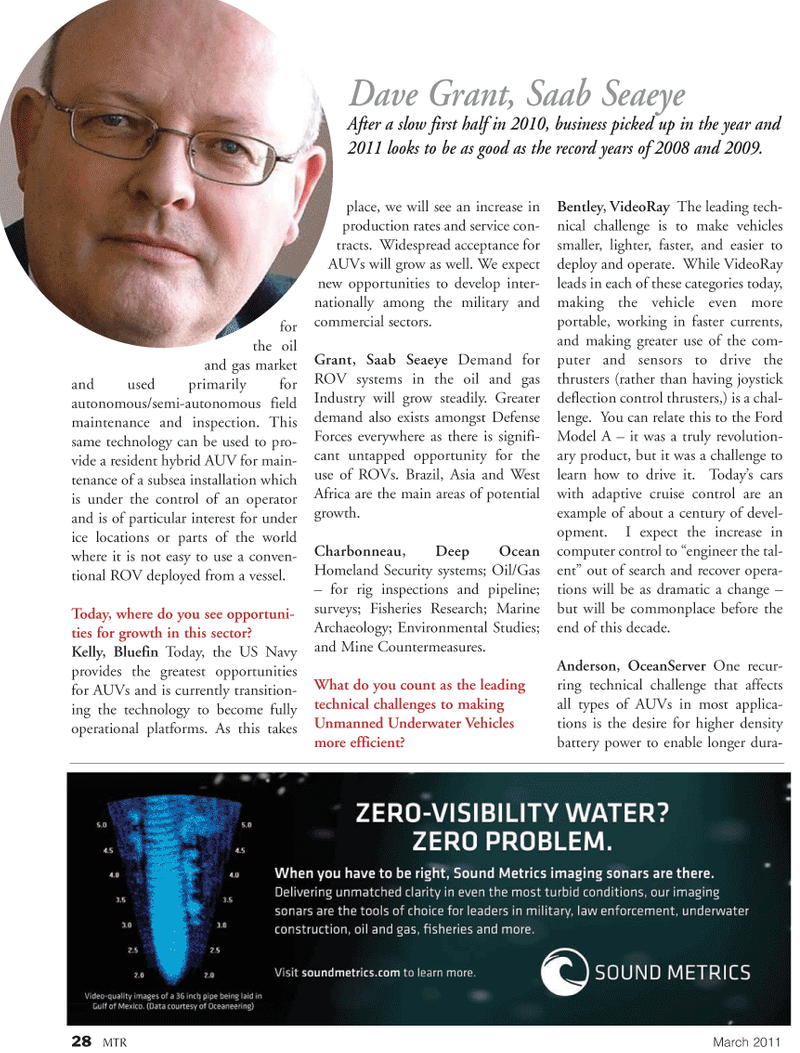
Page 28: of Marine Technology Magazine (March 2011)
Subsea Vehicles: AUV, ROV, UUV Annual
Read this page in Pdf, Flash or Html5 edition of March 2011 Marine Technology Magazine
28 MTR March 2011 for the oil and gas market and used primarily for autonomous/semi-autonomous field maintenance and inspection. This same technology can be used to pro- vide a resident hybrid AUV for main- tenance of a subsea installation which is under the control of an operator and is of particular interest for under ice locations or parts of the world where it is not easy to use a conven- tional ROV deployed from a vessel.
Today, where do you see opportuni- ties for growth in this sector?
Kelly, Bluefin Today, the US Navy provides the greatest opportunities for AUVs and is currently transition- ing the technology to become fully operational platforms. As this takes place, we will see an increase in production rates and service con- tracts. Widespread acceptance for
AUVs will grow as well. We expect new opportunities to develop inter- nationally among the military and commercial sectors.
Grant, Saab Seaeye Demand for
ROV systems in the oil and gas
Industry will grow steadily. Greater demand also exists amongst Defense
Forces everywhere as there is signifi- cant untapped opportunity for the use of ROVs. Brazil, Asia and West
Africa are the main areas of potential growth.
Charbonneau, Deep Ocean
Homeland Security systems; Oil/Gas – for rig inspections and pipeline; surveys; Fisheries Research; Marine
Archaeology; Environmental Studies; and Mine Countermeasures.
What do you count as the leading technical challenges to making
Unmanned Underwater Vehicles more efficient?
Bentley, VideoRay The leading tech- nical challenge is to make vehicles smaller, lighter, faster, and easier to deploy and operate. While VideoRay leads in each of these categories today, making the vehicle even more portable, working in faster currents, and making greater use of the com- puter and sensors to drive the thrusters (rather than having joystick deflection control thrusters,) is a chal- lenge. You can relate this to the Ford
Model A – it was a truly revolution- ary product, but it was a challenge to learn how to drive it. Today’s cars with adaptive cruise control are an example of about a century of devel- opment. I expect the increase in computer control to “engineer the tal- ent” out of search and recover opera- tions will be as dramatic a change – but will be commonplace before the end of this decade.
Anderson, OceanServer One recur- ring technical challenge that affects all types of AUVs in most applica- tions is the desire for higher density battery power to enable longer dura-
Dave Grant, Saab Seaeye
After a slow first half in 2010, business picked up in the year and 2011 looks to be as good as the record years of 2008 and 2009.

 27
27

 29
29
